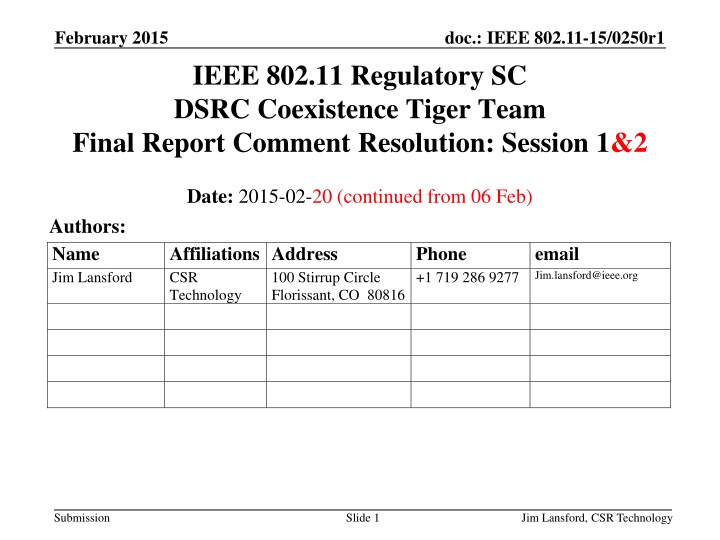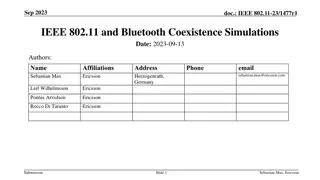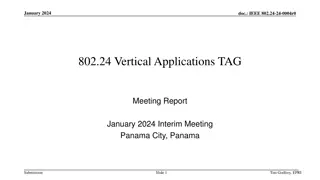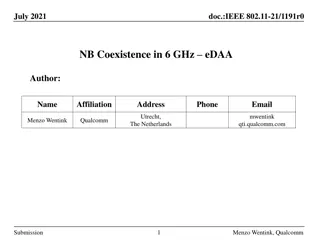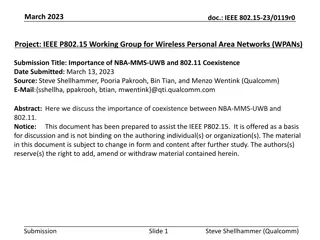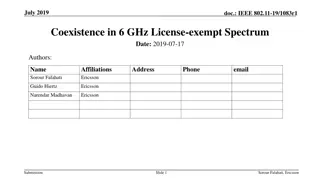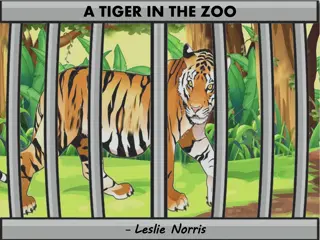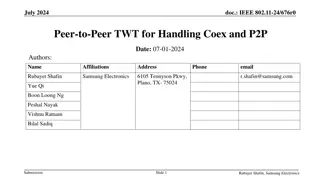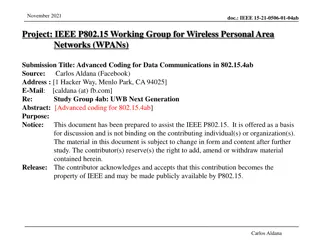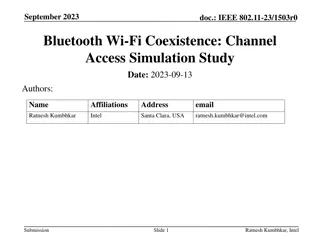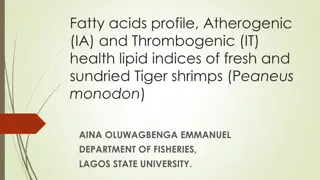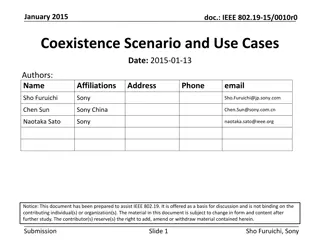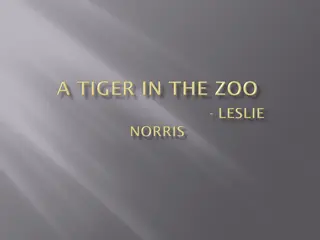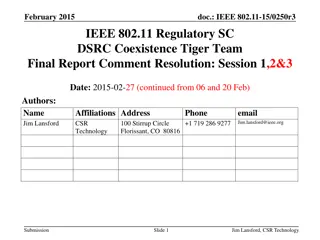IEEE 802.11 Regulatory SC DSRC Coexistence Tiger Team Final Report
February 2015 document presents the final report of the IEEE 802.11 Regulatory SC DSRC Coexistence Tiger Team. It includes comment resolutions, background information, and CID resolutions. The report addresses various proposed changes, editorial comments, and technical suggestions related to the automotive industry, frequency bands, and DSRC users' allocations.
Download Presentation

Please find below an Image/Link to download the presentation.
The content on the website is provided AS IS for your information and personal use only. It may not be sold, licensed, or shared on other websites without obtaining consent from the author.If you encounter any issues during the download, it is possible that the publisher has removed the file from their server.
You are allowed to download the files provided on this website for personal or commercial use, subject to the condition that they are used lawfully. All files are the property of their respective owners.
The content on the website is provided AS IS for your information and personal use only. It may not be sold, licensed, or shared on other websites without obtaining consent from the author.
E N D
Presentation Transcript
February 2015 doc.: IEEE 802.11-15/0250r1 IEEE 802.11 Regulatory SC DSRC Coexistence Tiger Team Final Report Comment Resolution: Session 1&2 Date: 2015-02-20 (continued from 06 Feb) Authors: Name Jim Lansford Affiliations Address CSR Technology Phone +1 719 286 9277 email Jim.lansford@ieee.org 100 Stirrup Circle Florissant, CO 80816 Submission Slide 1 Jim Lansford, CSR Technology
February 2015 doc.: IEEE 802.11-15/0250r1 Abstract Number 1 and 2 of 4 scheduled comment resolution sessions. Submission Slide 2 Jim Lansford, CSR Technology
February 2015 doc.: IEEE 802.11-15/0250r1 Background Final report draft was posted as document 14/1596. Latest version is r1 r2 https://mentor.ieee.org/802.11/dcn/14/11-14-1596-02-0reg-final- report-of-dsrc-coexistence-tiger-team.docx Comments on 14/1596r0 were collected and posted as document 15/175r1 (latest is r2) https://mentor.ieee.org/802.11/dcn/15/11-15-0175-02-0reg-dsrc- coex-tt-final-report-consolidated-comments.xls CID number is row number in this spreadsheet Will mostly address editorial comments this week Submission Slide 3 Jim Lansford, CSR Technology
February 2015 doc.: IEEE 802.11-15/0250r1 CID resolution 1/9 Must Be Satisfie d Page Numb er Line Numb er Proposed Resolutio n Catego ry Subcla use CID Comment the automotive industry did not originate a petition to FCC in 1999 Proposed Change 5 change "the automotive industry" to "ITS stakeholders" Before "Highlights of the proposal are:", insert the following sentence: "Note: several of the numeric values listed below are intended to be subject to further discussion." General 2 2 34 Yes Accept Suggest at the outset of explaining 13-0994 that it be noted that several numerical values are intended to be the subject of further discussion Suggest more specifically noting that 13-0994 calls for the band 5825-5925 to be declared busy Suggest changing "packet in the U-NII-4 band" to "U-NII-4 packet" so that there is no confusion that the statement might apply to any packet (including DSRC packets) in the band The mention of the "primary DSRC user" might be confusing. It might imply that some DSRC users are primary and others are not. I believe it is intended to note that DSRC's FCC allocation is primary in the band. 13 14 Editorial 9 59 Yes Accept Technic al Change "the medium" to "the frequency band 5825-5925 MHz"Yes 9 66 Accept 15 Change "packet in the U-NII-4 band" to "U-NII-4 packet" Editorial 9 70 No Accept Change "primary DSRC user" to "DSRC user (with primary spectrum allocation from the FCC)" 17 Editorial 9 75 No Accept Submission Slide 4 Jim Lansford, CSR Technology
February 2015 doc.: IEEE 802.11-15/0250r1 CID resolution 2/9 Page Num ber Sub clau se Line Num ber Must Be Satisfied Proposed Resolution CID Comment "previous detection" could be ambiguous since there might be multiple of these Qualify "current CCA mechanism" to be "current 802.11ac CCA mechanism" Category Proposed Change change "previous" to "most recent" Change "current CCA mechanism" to "current 802.11ac CCA mechanism" Change "in the case of DSRC," to "in the case that a U-NII-4 device wants to detect DSRC," Change "from the automotive and Wi-Fi communities" to "from the DSRC and Wi-Fi communities" 18 Editorial 9 83 No Accept 23 Editorial 9 99 No Accept 25Clarify "in the case of DSRC" Editorial 9 102 No Accept Change "automotive" to "DSRC" When we say the TT work has laid the groundwork for field testing, it should be qualified to note that field testing won't be able to proceed until a proposal is fully defined and prototype Wi-Fi equipment is available Technical 13 30 Editorial 12 63 No Accept after "field testing," insert "once one or more sharing proposals are fully developed and prototype Wi-Fi devices become available," 31 75 Yes Accept Submission Slide 5 Jim Lansford, CSR Technology
February 2015 doc.: IEEE 802.11-15/0250r1 CID resolution 3/9 With the release of FCC NPRM 13-22 (Docket 13-49), the United States Federal Communications Commission has requested comments regarding allowing unlicensed devices such as those using 802.11-based standards to share the 5.9 GHz ITS band, which is currently allocated for DSRC, government radiolocation, and non-government fixed satellite service (FSS) operations. If additional sharing is allowed, the FCC would create a new set of rules for the band that would become U-NII-4. This report describes the work of the Tiger Team since its inception in August 2013, summarizes the issues surrounding the proposed band sharing ideas discussed in the group, assesses the level of support for these concepts among the members of the group, certain initial sharing methods among participants, and recommends next steps for validating the sharing methods. The goal of this document is to inform regulators about initial discussions regarding the feasibility and practicality of sharing the 5.9 GHz ITS band and outlining future analysis and field/lab testing that needs to take place to assure that these techniques will adequately protect safety-related DSRC transmissions from harmful interference when deployed in the mass market. The 5.9 GHz band should not be referred to as the "ITS band" as other incumbents operate here and the FCC does not use this terminology; references to incumbents in the band should include government radiolocation and non-government FSS. Any new sharing of the band permitted by the FCC would be in addition to sharing among primary users of the band. 32 General 1 4 Yes Accept 33 Editorial 1 4 No Accept The straw poll will be evaluating only support for initial sharing methods. 34 General 1 4 No Accept The 5.9 GHz band should not be referred to as the "ITS band." Depending upon the sharing solution identified, lab testing may be appropriate. Protection from harmful interference should focus on the safety- related DSRC services that are currently planned for the band, rather than potential future services that are not safety-related. General 1 35 4 Yes Accept Submission Slide 6 Jim Lansford, CSR Technology
February 2015 doc.: IEEE 802.11-15/0250r1 CID resolution 4/9 The FCC allocated 75MHz of spectrum in the 5.9GHz band (5850-5925MHz) for Dedicated Short Range Communications (DSRC) in October 1999, on a shared basis with government radiolocation and non- government FSS operations. References to incumbents in the band should include government radiolocation and non-government FSS. Because DSRC already shares the band with FSS and radiolocation, a reference to "further" sharing is appropriate. The 5.9 GHz band should not be referred to as the "DSRC band." Note also that a sharing solution must protect not only DSRC but also other incumbents. References to incumbents in the band should include government radiolocation and non-government FSS. In March 2014, the FCC adopted new rules for U-NII-1 that now allow transmit powers up to 1W under certain circumstances. Because the FCC has already adopted the new nomenclature for the 5 GHz bands, we propose referring to them by their new names. Because the FCC has already adopted the new nomenclature for the 5 GHz bands, we propose referring to them by their new names. 36 General 2 7-8 Yes Accept In the FCC NPRM 13-22 (13-49), the FCC requested comments on a potential further sharing of the DSRC 5.9GHz band, to understand if a feasible sharing solution that protects DSRC other users could be developed. DSRC, government radiolocation, and non- government FSS would remain as a primary users of the band, but if sharing is allowed, this new band would be designated U-NII-4. Yes 37 General 2 9-10 No Accept 38 General 2 10-11 Accept Reject wording added to clarify original vs new designation 39 General 2 27 250-1000 Yes Reject see CID 39 40 General 2 27 U-NII-2A No Reject see CID 39 41 General 2 27 U-NII-2Ce No Submission Slide 7 Jim Lansford, CSR Technology
February 2015 doc.: IEEE 802.11-15/0250r1 CID resolution 5/9 As shown in Fig. 1, these rules defined a band plan that reserved 5 MHz at the low end of the band (5.850-5.855 GHz) for future developments as a guard band and specified seven 10 MHz channels, i.e. Ch. 172 (5.855- 5.865 GHz) through 184 (5.915-5.925 GHz). The focus of the research is V2V communication of vehicle state information (location, speed, acceleration, heading, etc.) through so-called Basic Safety Messages (BSMs) [9], and the development of collision- avoidance applications that use the BSM data to identify potential collision threats and take appropriate action, e.g. warn the driver or control the vehicle. In response to the rapidly accelerating adoption of Wi-Fi, particularly the emerging 802.11ac standard, the FCC issued a Notice of Proposed Rulemaking (NPRM) in early 2013 that proposed adding 195MHz of additional 5GHz spectrum for use by unlicensed devices such as Wi-Fi. In addition, the NPRM proposed changes in the existing U-NII-1, U-NII-2A, and U-NII- 2e2C bands to make them more useful for unlicensed devices, including making U-NII-1 available outdoors and streamlining the DFS process for U-NII-2 and U-NII-2e (a portion of these new rules have been approved; see [2]). The FCC did not specify that this was to be a guard band, but instead refers to it as a "reserve channel" "to accommodate future, unforeseen developments." 42 Editorial 3 42 Yes Accept At this time, NHTSA is not proposing that V2V collision-avoidance applications be used to control the vehicle. Most commenters in the NHTSA proceeding suggested that, in fact, it may not be appropriate for V2V to do more than warn the driver. 43 Editorial 3 60 No Accept The FCC's 2013 NPRM dealt specifically with the 5 GHz band. 45 General 3 79 No Accept Reject wording added to clarify original vs new designation Because the FCC has already adopted the new nomenclature for the 5 GHz bands, we propose referring to them by their new names. 46 General 4 80 No Submission Slide 8 Jim Lansford, CSR Technology
February 2015 doc.: IEEE 802.11-15/0250r1 CID resolution 6/9 As a reminder, the ITS band is 5.850-5.925 GHz band is allocated to ITS, radiolocation, and FSS, so the inclusion of this band in the NPRM would permit one additional 80 MHz and, one additional 160 MHz contiguous channel, and several possible non-contiguous 160 MHz channels for Wi-Fi operation. Unlicensed devices following standards other than 802.11 would also be permitted to operate anywhere in the bands labelled New in the figure. This has led to an initial flurry of dialog between tThe automotive and WLAN industries have thus engaged in dialog to discuss possible mechanisms that could facilitate DSRC-WLAN sharing in U-NII-4 while protecting safety-related DSRC functions from harmful interference., because the ITS band allocation at 5.9 GHz was not expected to be shared with unlicensed devices such as Wi-Fi. The fundamental issue is how to share the band in a fair way, given that DSRC has a higher precedence in the band. Because of the controversial nature of the FCC s NPRM that wouldproposed to allow band sharing between DSRC and a possible future variant of 802.11n and/or 802.11ac, and asked for industry comment on how such sharing could be achieved on a technical level, the Regulatory Standing Committee of the 802.11 working group created this DSRC Coexistence Tiger Team in August 2013 [12]. No The 5.9 GHz band should not be referred to as the "ITS band." This edit also amends the descriptions of the channels that would be permitted. 47 General 4 84-87 Yes Accept 48 Spelling error. Editorial 4 88 Accept The change proposed suggests more neutral wording that will more accurately characterize the ongoing dialogue and relevant issue. 53 General 4 99-104 Yes Accept The change proposed suggests more neutral wording that will more accurately characterize the FCC's NPRM. 107- 109 54 General 5 Accept Submission Slide 9 Jim Lansford, CSR Technology
February 2015 doc.: IEEE 802.11-15/0250r1 CID resolution 7/9 Only IEEE 802.11 Working Group members may vote on certain matters before the Regulatory Standing Committee, but anyone has been able to participate in this Tiger Team discussionsactivity, and to date the group has attracted a broad spectrum of participants from the automotive industry, 802.11/Wi-Fi chip and system vendors, and other stakeholders from government and industry. It is important to describe both the voting and participation rules. 55 56 General 5 116-119 No Accept Spelling error. Editorial 5 125 Modelling/simulation of possible coexistence approachesNo 9. Proposal 1: Sharing using DSRC channelization and CCA in 10MHz channels Accept 58 59 Spelling error. Editorial 6 183 Accept Specifies type of detection for clarity. Without the edit, this sentence is speculative; at this early stage, one should not make assumptions about what would or would not be cost effective for particular categories of unlicensed devices. General 6 191 Detection of DSRC by WLAN in 5850-5925 MHz No Accept From a practical perspective, non-Wi-Fi devices would likelymay not find adding this CCA mechanism cost effective, so sharing based on CCA-detection would likely be limited to Wi-Fi devices. Extensive testing would be required to make sure that deployment of these Wi-Fi systems would not impact the critical safety-related functions of DSRC systems, particularly collision avoidance. 60 General 7 218-220 Yes Accept Clarifies that the critical functions of DSRC are the safety-related functions.General 7 63 240 No Accept Another proposal that has been made in the group suggests modifications to the existing far more significant changes to DSRC[18][19]; it would revamp the existing band plan as defined in the FCC Report and Order 03-324 and allows unlicensed devices such as Wi- Fi to share only the lower 45MHz portion of the band, while reserving several channels at the top of the band exclusively for the use of DSRC safety-related systems. Yes The report of the group should avoid characterizing the proposals at issue with adjectives like "far more significant." Revision reflects more neutral language. Revision also provides additional clarity about the nature of the Qualcomm proposal. 64 General 7-8 245-249 Accept Submission Slide 10 Jim Lansford, CSR Technology
February 2015 doc.: IEEE 802.11-15/0250r1 CID resolution 8/9 The Tiger Team consisted of xx members who wished to have their names recorded for purposes of the a straw poll; their names are listed in Appendix A. Field trials will be an important part of evaluating DSRC coexistence in the U-NII-4 band; as analysis continues on these proposals beyond the time frame of this Tiger Team, prototype development sharing technologies should can occur in parallel. It is assumed that stakeholders from the Automotive and Wi-Fi communities, as well as potentially from government agencies, will participate in field/lab testing of any of these candidate spectrum sharing technical solutions. The proposed sharing of the ITS/DSRC band from 5.85-5.925 GHz poses numerous technical challenges that the WLAN and automotive industries must address to make sure that the applications including crash avoidance - enabled by DSRC are not harmedfully interfered with by unlicensed users of this band. Breaks up what is now a long sentence into two and suggests a grammatical change. 71 Editorial 8 279-280 No Accept 73 Suggests minor editorial edit. Editorial 9 290 No Accept Reflects that both lab and/or field testing could be appropriate depending upon the sharing mechanism selected. 74 Editorial 9 298 Yes Accept Reflects that the relevant standard is harmful interference, not general harm. 75 Editorial 9 305 Yes Accept Submission Slide 11 Jim Lansford, CSR Technology
February 2015 doc.: IEEE 802.11-15/0250r1 CID resolution 9/9 "These new unlicensed bands will be designated" suggests something that is bound to happen, rather than something that has been suggested. "Initial flurry" is not a good description of the dialog. "The fundamental issue is how to share the band in a fair way, given that DSRC has a higher precedence in the band" is not a good description of the issue. Change to "These new unlicensed bands would be designated" or similar. Change to "This has led to a dialog" or similar. 79 Technical 4 4 90 Yes Accept Accept - see CID 53 80 Editorial 4 4 96 No Change to "The fundamental issue is whether the band can be shared in a way that does not impact the ability of DSRC to support its mission, and if so, how." "Another proposal that has been made in the group suggests far more significant changes to DSRC[18][19] channelization; it would revamp " Reject in favor of proposed text in CID 53 81 Technical 4 4 98 Yes Text edit change to neutralize the tone Reject in favor of proposed text in CID 64 General 7 10 211 93 No change to IEEE spec is necessary. Remove the last sentence in Section 10. 94 Accept Submission Slide 12 Jim Lansford, CSR Technology
February 2015 doc.: IEEE 802.11-15/0250r1 Conclusion This completes most of the editorial and general comments Will continue with other comments on next call Submission Slide 13 Jim Lansford, CSR Technology
